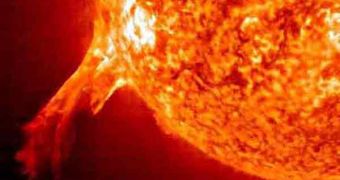A new discovery made by NASA's Wind spacecraft (launched in November 1994 and deployed to study radio and plasma that occur in solar wind, in the Earth's magnetosphere), showed that helium acts like a sort of throttle for solar wind, regulating its speed by setting a minimum one.
The solar wind is a stream of diffuse charged particles in the form of plasma, ejected from the upper atmosphere of the sun. Consisting mostly of high-energy electrons and protons (about 1 keV) that are able to escape the sun's gravity, it becomes an electrically conducting gas.
Justin Kasper, a research scientist at MIT's Kavli Institute for Astrophysics and Space Research, is the lead author of a paper on this research, and said that: "This result gives us another clue about how the solar wind is accelerated, which may help us better understand space weather."
Astronomers discovered some time ago that the solar corona is being blown into space as solar wind that blows at a minimum speed of about 260 kilometers per second (161 miles/second). No one knows why this particular speed is in effect.
Helium is the second most detected element in the solar wind, even though it's more rare in the solar wind than it is elsewhere in the Universe. The team discovered that the percentage of helium in solar wind increased with its speed, from near zero around the minimum speed to more than four helium atoms for every 100 hydrogen atoms at speeds greater than about 500 kilometers per second (310 miles/second).
Thus, they say it's helium which dictates the minimum speed of the wind, as hydrogen atoms inside the solar wind drag along the helium ones, which can't accelerate beyond the speed of hydrogen and slows down these atoms, setting a minimum "speed limit."
"It's still not clear exactly how the helium sets the minimum speed at its particular value of around 260 kilometers per second, or why more helium is found as the solar wind speed increases, but it's a clue that we are missing something fundamental about what makes the solar wind blow," said Kasper.

 14 DAY TRIAL //
14 DAY TRIAL //